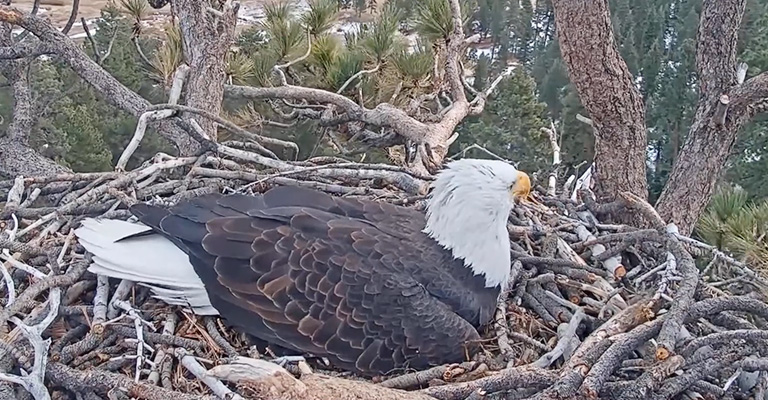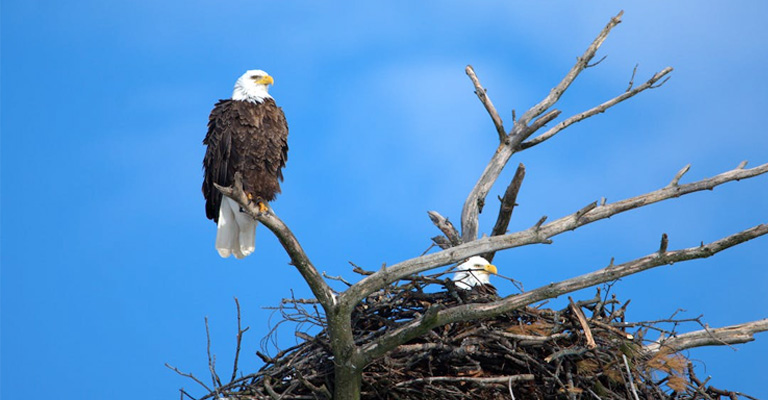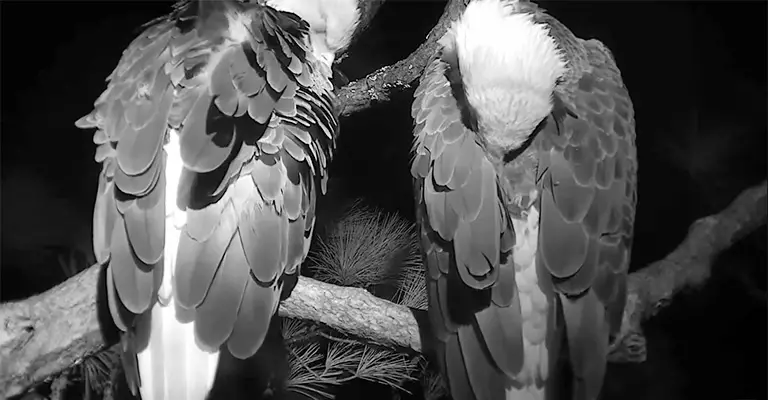The bald eagle, a symbol of strength, freedom, and majesty, is an iconic bird of prey that captivates the imagination of many. As one of North America’s most recognizable raptors, the lives of these birds are often shrouded in mystery.
Beyond their soaring flights and formidable hunting skills, have you ever wondered how do bald eagles sleep? In this article, we’ll delve into the fascinating world of bald eagle sleep patterns.
From their impressive nests perched high in trees or atop cliffs, to the isolated and remote locations they often call home, bald eagles lead intriguing lives.
But when the day comes to a close, and the sun sets on their expansive territories, what exactly happens in the realm of eagle slumber?
We’ll explore their unique adaptations, the locations they choose for rest, and the behaviors they exhibit during sleep. Join us on a journey to uncover the secrets of how these regal birds find their repose amidst the wild landscapes they call home.

How Do Bald Eagles Sleep?
Bald eagles are known for their choice of impressive nests, which can weigh up to a ton and be over ten feet wide.
These nests, often placed in the tallest trees or on cliffs, serve as both a living space and a sleeping location. Eagles return to these nests for sleep and refuge.
Bald Eagle Sleeping Habits
Eagles have unique adaptations when it comes to sleep. One striking behavior is their ability to sleep with one eye open. This remarkable adaptation allows them to remain vigilant for potential threats even during sleep.
Their extraordinary vision, which is around four to eight times better than human vision, aids them in this endeavor.
Eagle Sleep Cycle
Eagles, like many birds, have a sleep cycle different from that of mammals. They alternate between rapid eye movement (REM) sleep and non-REM sleep.
During REM sleep, their brains are active, possibly involved in processing information and memory consolidation. Non-REM sleep is more restful. The alternating pattern keeps them alert even during rest.
Sleep Duration
The amount of sleep eagles need can vary depending on factors like their age and the time of year. Young eagles and those in the breeding season might sleep less. On average, adult eagles sleep for approximately 4-5 hours a day.
Sleeping Alone or Together
Bald eagles can sleep both alone and together. During the breeding season, a pair may sleep together in their nest. This bonding helps strengthen their partnership and enhance their success in raising their young.
Outside of the breeding season, they may sleep alone to reduce disturbance.
The Role of Roosts

In addition to their nesting sites, eagles often use roosts as secondary sleeping locations. Roosts are typically chosen for their proximity to hunting areas and protection from harsh weather. These roosts might be in dense trees or sheltered cliffs.
Challenges to Eagle Sleep
Despite their impressive adaptations, bald eagles face challenges while sleeping. Harassment from other birds, especially crows and gulls, can disturb their rest. Eagles must always be on alert to protect their nests and territory.
Conservation and Protection
Understanding bald eagle sleep is essential in their conservation. Protecting their nesting and roosting sites is critical to their survival. Laws like the Bald and Golden Eagle Protection Act ensure the safety of these birds, their nests, and their habitats.
The Fascinating World of Eagle Sleep
The sleeping habits of bald eagles provide a unique window into their world. Their adaptations for vigilance, the choices they make for sleeping locations, and the alternating sleep cycle are just a few aspects that make them a remarkable species.
As we strive to protect these magnificent birds, we must also respect their sanctuaries and the intricate way they rest amidst the wild landscapes they call home.
Where Do Bald Eagles Sleep at Night?

Have you ever wondered where these iconic raptors rest their heads at night? In this in-depth exploration, we will unravel the mystery of where bald eagles sleep and discover the secrets of their nocturnal sanctuaries.
The Nesting Habit
Bald eagles are renowned for their massive nests, which they build in sturdy trees or on high cliffs. These nests, also known as aeries, serve as multi-purpose structures, providing not only a place for raising their young but also a primary location for resting.
These nests are substantial and can weigh up to a ton and span more than ten feet wide, offering ample space for both adults and their eaglets.
High and Remote: The Preferred Sleeping Locations
Eagles prefer to sleep in their nests, elevated high above the ground. This choice serves multiple purposes.
First, it keeps them safe from ground predators, like raccoons or foxes. Second, the elevated location provides them with a clear vantage point to monitor their territory and potential prey.
Being perched high in trees or on cliffs, bald eagles have a bird’s eye view of their surroundings, allowing them to spot threats or opportunities from a distance.
Sleeping with One Eye Open: Vigilance at All Times
One of the most astonishing aspects of bald eagle sleep is their ability to sleep with one eye open, quite literally. This adaptation allows them to remain vigilant even while resting.
Eagles have incredible vision, estimated to be four to eight times sharper than human vision. The eye that remains open during sleep can quickly detect any movement or disturbance, ensuring their safety throughout the night.
The Eagle Sleep Cycle
Bald eagles, like most birds, have a unique sleep cycle. They alternate between rapid eye movement (REM) sleep and non-REM sleep. During REM sleep, their brains are active, possibly involved in processing information and memory consolidation.
On the other hand, non-REM sleep is more restful. This alternating pattern allows them to remain alert even during their periods of rest.
The Duration of Sleep
The amount of sleep an eagle needs can vary depending on various factors, including their age and the time of year. Young eagles may sleep less than adults, as they require more energy for growth and development.
During the breeding season, eagles often sleep less because they are actively engaged in caring for their young. On average, adult bald eagles sleep for approximately 4 to 5 hours a day.
Solo or Together: Sleeping Habits
Bald eagles can sleep both alone and together, and their sleeping habits change depending on the time of year. During the breeding season, a mated pair may choose to sleep together in their nest.
This behavior reinforces their bond and collaboration in raising their eaglets. Outside of the breeding season, they may sleep alone to reduce disturbances, ensuring their undisturbed rest.
The Role of Roosts
In addition to their nesting sites, bald eagles often utilize roosts as secondary sleeping locations. Roosts are chosen for their proximity to hunting areas and protection from harsh weather conditions.
These roosts can be found in dense trees or sheltered cliffs, serving as temporary overnight refuges. Roosts are essential for conserving their energy and staying safe during inclement weather.
Challenges to Eagle Sleep
Despite their impressive adaptations, bald eagles face challenges during their sleep. They are often harassed by other birds, particularly crows and gulls, which may disrupt their rest.
Bald eagles must always be on alert, even during sleep, to protect their nests and territory from potential threats.
Conservation and Protection
Understanding where bald eagles sleep is crucial for their conservation. Protecting their nesting and roosting sites is vital to their survival.
Legal measures like the Bald and Golden Eagle Protection Act ensure the safety of these magnificent birds, their nests, and the habitats they rely on.
The sleeping habits of bald eagles provide a unique glimpse into the life of these magnificent birds. From their choice of lofty nesting locations to their incredible ability to sleep with one eye open, the secrets of where and how they sleep add to the wonder of these iconic raptors.
FAQs
How long do bald eagles sleep?
Bald eagles typically sleep for about 4 to 5 hours a day on average. However, the amount of sleep they need can vary depending on factors such as their age and the time of year.
Do bald eagles sleep in their nests at night?
Yes, bald eagles often sleep in their nests at night. Their nests, also known as aeries, serve as both a place for raising their young and a primary location for resting.
Why do bald eagles sleep with one eye open?
Bald eagles sleep with one eye open as an adaptation for vigilance. This remarkable behavior allows them to remain alert to potential threats even during sleep.
Do bald eagles sleep alone or together?
Bald eagles can sleep both alone and together, and their sleeping habits change depending on the time of year. During the breeding season, a mated pair may sleep together in their nest, reinforcing their bond.
What is the importance of protecting bald eagle nesting and roosting sites?
Protecting bald eagle nesting and roosting sites is essential for their conservation. Legal measures like the Bald and Golden Eagle Protection Act aim to ensure the safety of these birds, their nests, and the habitats they rely on.
Conclusion
The sleeping habits of bald eagles offer a glimpse into the remarkable world of these magnificent birds. From their towering nests to their choice of remote locations, eagles have evolved a unique way of resting that suits their impressive lifestyle.
The adaptations they’ve developed, like sleeping with one eye open to remain vigilant, showcase their innate survival skills.
Understanding how bald eagles sleep not only deepens our appreciation for these majestic creatures but also highlights the delicate balance of nature. As we strive to protect their habitats and ensure their continued existence, it’s crucial to respect the sanctity of their resting places.
So, the next time you catch a glimpse of a bald eagle in the wild, remember that it’s not only a symbol of freedom and strength but also a testament to the intricate and fascinating ways of the natural world.
The mysterious world of eagle sleep is just one of the many aspects that make these birds a true wonder of North America’s wilderness.
Meta: